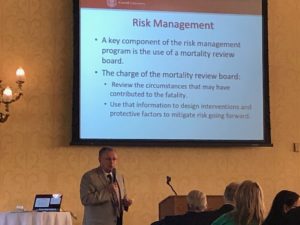Posted: Oct. 5, 2019
More than 60 racing industry stakeholders representing regulators, horsemen and racetrack operators from the seven states that comprise the Mid-Atlantic region—Delaware, Maryland, New Jersey, New York, Pennsylvania, Virginia, and West Virginia—11 jurisdictions, and 17 racetracks moved Oct. 2 to take the next steps toward implementation of the Mid-Atlantic Strategic Plan to Reduce Equine Fatalities.
The meeting was held at Delaware Park. It followed a similar meeting in March at which the representatives formally endorsed the strategic plan, which places the focus on equine health and welfare. The most important member of the racing community was not at the table but was the voice heard most loudly during the nearly six hours of discussion.
 “If we had a horse in the room with us today, what would he ask of us?” New York State Equine Medical Director Dr. Scott Palmer said. “That is what must guide us. That is our mandate.”
“If we had a horse in the room with us today, what would he ask of us?” New York State Equine Medical Director Dr. Scott Palmer said. “That is what must guide us. That is our mandate.”
With that in mind, the alliance agreed unanimously to immediately move to adopt rules that will prohibit the administration of any non-steroidal anti-inflammatory medication to a horse within 48 hours of a race, and all intra-articular joint injections within 14 days of a race.
“NSAIDs and corticosteroids are therapeutic treatments used not just here in the U.S., but worldwide, to the benefit of the health of the horse,” Palmer said. “However, sound medical practice dictates that we allow our veterinarians and horsemen the proper time to evaluate these horses following treatment and before returning them to high-speed exercise. Amending our regulations to reflect this best practice is a vital step in implementing the strategic plan.”
The Mid-Atlantic stakeholders group, which announced a ban on the use of bisphosphonates in horses under the age of four in March, also formally adopted a model rule to effectuate the ban.
Palmer gave presentations on risk management programs, mortality review protocols, and injury clusters. Dr. Mick Peterson, who serves as director of the University of Kentucky Agricultural Equine Programs and is Executive Director of the not-for-profit Racing Surfaces Testing Laboratory, provided a presentation on track maintenance and how the region can develop and implement best practices to assess racing surfaces to ensure a consistently safe racing environment.
All participating jurisdictions completed a 27-point Gap Analysis of the strategic plan’s requirements prior to the meeting and their efforts to fully implement the plan were reviewed. The analysis covers topics including claiming and medication regulations, track maintenance, trainer and veterinarian education, the collection and review of equine and rider injury data, and risk management.
“The results of the Gap Analysis will be used to prioritize our goals,” said Alan Foreman, Chairman of the Thoroughbred Horsemen’s Association. “We will work to develop best practices for every element of the strategic plan. This is a living document. We will refine our goals as we go through the process and we will also provide updates on our progress.
“The unanimous adoption of the medication rules at the meeting demonstrates a united commitment to the health and welfare of the horse, and is just one of many steps that will be taken to achieve our goals.”
The Mid-Atlantic Strategic Plan to Reduce Equine Fatalities is the product of a collaboration of the region’s racetrack operators, horsemen’s organizations, breeders’ organizations, racing commissions and regulatory and racetrack veterinarians. Many phases of the plan stem from the 2012 New York Task Force Report on Race Horse Health and Safety and are already in practice.
The plan incorporates five key goals, including the establishment of regional safety best practices, improved methods to identify horses at increased risk of injury, the implementation of protective factors to reduce the risk of injury, information sharing and communication, and improvement of the general health and welfare of the horse.
Mid-Atlantic Strategic Plan to Reduce Equine Fatalities
The Mid-Atlantic stakeholders and regulators who have committed to the strategic plan include Delaware Park; Delaware THA; Delaware Thoroughbred Racing Commission; Maryland Jockey Club; Maryland State Fair at Timonium; Maryland THA; Maryland Racing Commission; Maryland Horse Breeders Association; Monmouth Park; New Jersey THA; New Jersey Racing Commission; Thoroughbred Breeders Association of New Jersey; Finger Lakes Gaming & Racetrack; New York Racing Association; Finger Lakes HBPA; New York THA; New York State Gaming Commission; New York Thoroughbred Breeders Inc.; Penn National Gaming Inc.; Parx Racing; Presque Isle Downs & Casino; Pennsylvania THA; Pennsylvania HBPA; Pennsylvania Horse Racing Commission; Pennsylvania Horse Breeders Association; Colonial Downs; Virginia Racing Commission; West Virginia Racing Commission; Mountaineer Casino, Racetrack & Resort; Mountaineer HBPA; Charles Town HBPA; West Virginia Racing Commission; and National Steeplechase Association.
(Dr. Scott Palmer discusses risk management/THA photo)
 Thoroughbred Horsemen's Association
Thoroughbred Horsemen's Association


